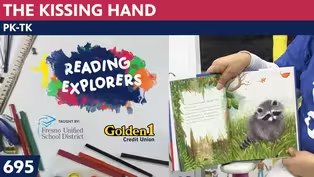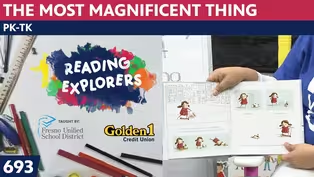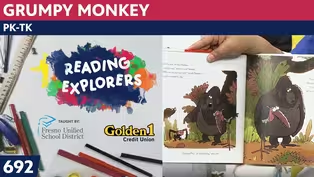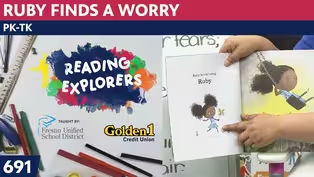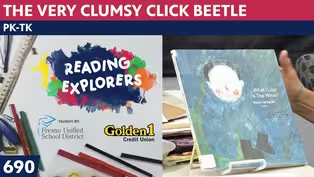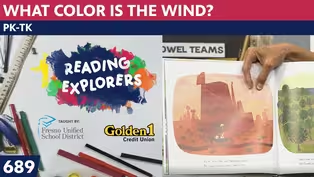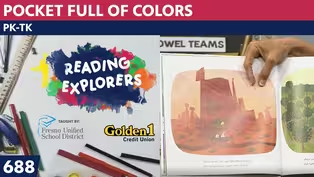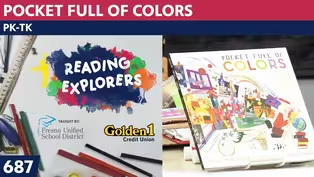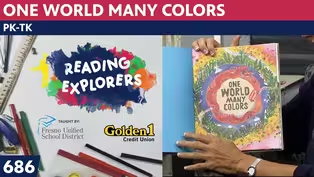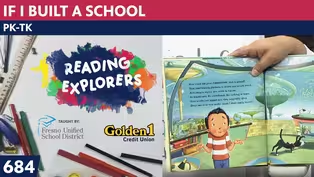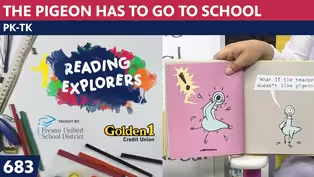
TK-370: Chalk Pastel Water Lilies
Season 3 Episode 391 | 14m 6sVideo has Closed Captions
Join Mrs. Readwright at Camp Discovery!
Join me today as we finish our Monet Water Lilies study. Each day we have introduced Monet's masterpieces that show his interest in the pond on his property in Giverny, France. We will use the painted paper we prepared earlier in the week.
Problems playing video? | Closed Captioning Feedback
Problems playing video? | Closed Captioning Feedback
Reading Explorers is a local public television program presented by Valley PBS

TK-370: Chalk Pastel Water Lilies
Season 3 Episode 391 | 14m 6sVideo has Closed Captions
Join me today as we finish our Monet Water Lilies study. Each day we have introduced Monet's masterpieces that show his interest in the pond on his property in Giverny, France. We will use the painted paper we prepared earlier in the week.
Problems playing video? | Closed Captioning Feedback
How to Watch Reading Explorers
Reading Explorers is available to stream on pbs.org and the free PBS App, available on iPhone, Apple TV, Android TV, Android smartphones, Amazon Fire TV, Amazon Fire Tablet, Roku, Samsung Smart TV, and Vizio.
Providing Support for PBS.org
Learn Moreabout PBS online sponsorshipMore from This Collection
Valley PBS and Fresno Unified School District have partnered with Golden 1 Credit Union to create Reading Explorers Lessons for grades Pre-Kindergarten through Third grade. The daily lessons will be taught by Fresno Unified School District teachers and are created to help students practice their reading skills and reinforce lessons during distance learning.
Video has Closed Captions
Valley PBS presents Reading Explorers Lessons for Pre-Kindergarten and TK. (26m 27s)
PK-TK-693-The Most Magnificent Thing
Video has Closed Captions
Valley PBS presents Reading Explorers Lessons for Pre-Kindergarten and TK. (26m 26s)
Video has Closed Captions
Valley PBS presents Reading Explorers Lessons for Pre-Kindergarten and TK. (26m 28s)
Video has Closed Captions
Valley PBS presents Reading Explorers Lessons for Pre-Kindergarten and TK. (26m 28s)
PK-TK-690: The Very Clumsy Click Beetle
Video has Closed Captions
Valley PBS presents Reading Explorers Lessons for Pre-Kindergarten and TK. (26m 22s)
PK-TK-689: What Color is the Wind?
Video has Closed Captions
Valley PBS presents Reading Explorers Lessons for Pre-Kindergarten and TK. (26m 21s)
PK-TK-688: Pocket Full of Colors
Video has Closed Captions
Valley PBS presents Reading Explorers Lessons for Pre-Kindergarten and TK. (25m 58s)
PK-TK-687: Dancing Through Fields of Colors
Video has Closed Captions
Valley PBS presents Reading Explorers Lessons for Pre-Kindergarten and TK. (26m 20s)
PK-TK-686: One World Many Colors
Video has Closed Captions
Valley PBS presents Reading Explorers Lessons for Pre-Kindergarten and TK. (27m 13s)
PK-TK-685: School is Wherever I am
Video has Closed Captions
Valley PBS presents Reading Explorers Lessons for Pre-Kindergarten and TK. (26m 32s)
PK-TK-684: If I Built a School
Video has Closed Captions
Valley PBS presents Reading Explorers Lessons for Pre-Kindergarten and TK. (26m 21s)
PK-TK-683: The Pigeon Has to Go to School
Video has Closed Captions
Valley PBS presents Reading Explorers Lessons for Pre-Kindergarten and TK. (26m 22s)
Providing Support for PBS.org
Learn Moreabout PBS online sponsorship(upbeat guitar music) ♪ Good morning to a brand-new day ♪ ♪ Time to learn and games to play ♪ ♪ Learning things is so much fun ♪ ♪ Learning is good for everyone ♪ (upbeat guitar music) (playful music) - Hello, early learners!
Welcome back to the art room.
This week, we've been enjoying the paintings of Claude Monet.
His water-lily series was his biggest body of work, and before he moved on to the property in Giverny, he didn't have a pond.
He had to travel to see things like this, but he wanted to enjoy his pond day after day, and built his own pond.
Had people help him dig it out, had people help him fill it with water from the river, had people help him stop the river from coming in, because the lily pads need a still body of water to grow.
If it has too many waves, it will pull those roots out from under the ground.
Even some of the water-lilies will grow under the water.
The leaves never pop up to the top.
They just float under there under the water.
So if you have a pond at your house where you might be keeping some koi fish, the water-lilies are so good for the fish because they like to hide under there in the shadows of the lilies.
And you can buy those at the pet store even, sometimes.
Some people put them in their aquarium.
One of the lily pads that grows, I've seen one that is almost six-feet across.
So I'm six-feet tall, it is so tall!
It's a big lily pad that practically would cover a small pond!
But some of them are small, some of them are large.
And we talked about all the colors that the lilies themselves can be.
So lilies are really an interesting thing to study.
And it may be after this study of art that we've done, you'll want to find out more about ponds and about water-lilies.
Alright!
I've seen them at the nursery too, boys and girls.
They have big barrels, and you can go there and pick out the water plants.
It's really fun to have things growing.
We talked about things like that last week when we talked about Earth Day and Earth Week.
Wonder what you did for Earth Day?
Alright, let's start our day out with our Hello Song.
Ready?
(claps) ♪ Hello, nice to see you, everyone ♪ ♪ Hello, nice to see you, everyone ♪ ♪ Hello to you, hello to you ♪ ♪ Hello to you, hello to me ♪ ♪ Hello, nice to see you, everyone ♪ Let us take a look at today's art that I brought.
It's not the photographs of water-lilies, real ones, I did that for two days.
But today are two artworks by Claude Monet, and let's take a look at him and remember him.
So here it is, here's Claude Monet.
And sometimes I play a little game in my art class where I put up the artists without the name, and I ask them, "Everyone run, run to Vincent van Gogh!"
And they run over to stand by them, and they say, "Vincent van Gogh!"
And then I'd say, "Alright, get ready!
Next group, run to Claude Monet."
And they would run to the picture of Claude Monet and say, "Claude Monet!"
So maybe you'll have to remember, he had his beard.
A lot of artists then did have beards, but look at his face.
We might play a game later on before summer ends and see which artists you remember.
Now here I brought the close-up of a water-lily, and it is not green on the lily pad, it's blue.
And the reason he did that, because look at the water behind, it's the reflection of the trees.
And that is all green.
What happens when the background is the same color as the thing you're painting?
Well, it all blends together, and you can't tell one thing from another.
So what if this lily was green, and the lily pad was green, and the water was green?
It would just be green-painted paper.
So that is why he did a contrast.
This one has blues and greens and white in it.
So does this one, but it's a little different color.
Plus he did an outline, so you could see where one ends and one begins.
This one up here has a lot of green on the top but he also used white as an outline on that one.
So when you're painting these, because I'm sure today is not the last time you'll want to paint water-lilies, 'cause you've had some good practice.
And there's a blue and purply one up here, and here are the white lilies.
You can tell the center is slightly blue, and you can see those first leaves have their outline but not in green like we did yesterday.
These are outlined in magenta, which is a kind of a red pink with a little purple in it.
So that's the same with this one.
Take a look down here.
I wanted you to see this one because here are lily pads, and lilies.
Lily pads and lilies.
Lily pads and lilies, all of these are lily pads and lilies.
Here you can tell is the water that has been painted on with horizontal brush strokes.
This is the reflection of the tree, the tree has not fallen into the water.
It's up here somewhere, and its reflection is going into the pond which acts like a mirror.
And it makes it look like there is a tree there.
So what I did is bring my painted paper, it was blue, and I have my reflection on there.
And today we're going to be using our chalk pastels to make our lily pads and lilies on the painting.
But we're doing it as a mixed media.
When you use paint and another kind of material, it's called media.
When I use two different kinds of media it's called mixed because you do one and then another.
So it's a mixed media of chalk, pastels, and paint.
So let's take a look at how we're going to do this today.
And sing our song about "down by the pond, where the water lilies stand."
Ready?
♪ Down by the pond where the water-lilies stand ♪ ♪ I saw Monet with the paint brush in his hand ♪ ♪ his palette had its green, its yellow, and blue to ♪ ♪ paint the water lilies red and white were on there too ♪ Alright boys and girls, let me put my clipboard aside, and bring my art table up.
Now I've talked to you many times about how our oil pastels break.
If you're careful with them, even at your most careful sometimes they will break.
And you've seen me when I've been being very careful and mine have broken, and I'm going to turn this to you to see how I painted this.
You can see I did my horizontal water strokes down here.
I made a little lighter white and blue here, a little here and here, and here, and here, and it's on my light-blue piece of paper.
Then I use my paint brush.
I'll pretend I have paint on it.
And I did the vertical strokes.
Brush, brush, brush, brush, brush, brush, brush, brush brush, brush, brush, brush, down down down.
And I made it just like the one that we looked at today.
I'll bring it over so we have it as our inspiration.
Let me get it off of the clipboard.
I wonder if I will make everything else fall?
Just the blue paper.
See how similar it is?
Here's my painting, and here's Monet's painting.
And he has lots of different lily pads here.
I don't know if I want to do mine that small.
I'll see as I get started, but this is a project that when I wrote the art curriculum for pre-K for Fresno Unified, I did the project for pre-K to do lily pads using the chalk.
So I thought any of you who went to our pre-K classes have done this project.
So instead of being careful right now, I'm going to carefully break one of my chalk pastels.
'Cause I want my lily pad to be about, let me put it here so you can see, about this size.
And so when down here, I'm just going to take it and spin it in a circle by pressing down, and still using the edge, and stopping before I meet that other picture, where I started.
Maybe I'll do it outlined with a color so you can see where it went.
My fingers are already a mess.
So that's why I have my tissue here, and I also have paper towels.
I might get one paper towel a little wet so that I have a place to rub my fingers.
This material is very messy, so I tell parents don't put it right into your car.
And if you're doing this at home, a piece of newspaper behind it is good because as you get a lot of chalk dust, you might want to do this to it.
This is how I tell the children in the art class, tap-tap it on top of where your newspaper is.
Now look, I'm getting my white pastel and I'm kind of going around the outside.
Mostly so that you can see where it is, but I can go in like that.
And there is one of my lily pads, and I can make some really skinny little veins on it.
And any place when I was rubbing it, didn't get colored.
I can go back in and color it in again.
So watch me again, I'm going to do another one right here.
I'm going to start here and twist it in a circle, and I might even do it with yellow.
I like how yellow is done, because then I can go back in and blend it with some green and I'm going to stop.
We're almost to the place where I started.
Think I'll go around this one with a lime-green pastel.
And you can see where my lily pad kind of looks like, to you right now it looks like an upside-down heart.
I'm going to do another one right here as a reflection.
Up here, I think I'm making this one bigger.
I made my, stretched it out a little bit.
Get it over there.
I think I liked the white outline better, so I think I will use it and go around it.
And I can use my finger to blend this in, so that it goes in a little bit.
This blends so much easier than the oil does for me.
Not everyone thinks that, but see how I kind of make the line so it's not quite as sharp?
Doesn't look like, "Oh, she outlined that!"
It makes it look more like a real lily pad, and I just blended in some of those veins on that one.
Let me get my fingers.
See, I just rub it like this.
Try and get a little dry.
Alright, now, we know that the lily pad has the lily on it.
So I'm going to put my white, and each time I touch it, it gets a little greener.
So I have to be careful not to go over and over and over it again, because if that happens it'll make it light-green rather than a white lily.
So this is the part that I am putting on here, and then I can go back in with my magenta chalk and do the color in there.
Now, remember, if you just have crayons you can do the same thing.
Outline your lily.
I'll do one over here and show you.
I can outline my lily, and pretend I'm doing this with a crayon, boys and girls, just put my crayon around and make my petals.
I can go back in with the pink and make it dark too.
So don't worry about the materials, you know, it's about the process.
And do you have to make as many lilies as I?
No.
This is all about how you're making your art.
Boys and girls, it has been one terrific week doing Monet with you.
I've sure enjoyed myself.
So, I will see you next week when we are going to maybe do a bird study, I'm not quite sure yet.
So goodbye.
See you next time, everyone!
And we will study our birds and have a great time.
Bye-bye!
(upbeat guitar music) ♪ Good morning to a brand-new day ♪ ♪ Time to learn and games to play ♪ ♪ Learning things is so much fun ♪ ♪ Learning is good for everyone ♪ (upbeat guitar music)
Support for PBS provided by:
Reading Explorers is a local public television program presented by Valley PBS
